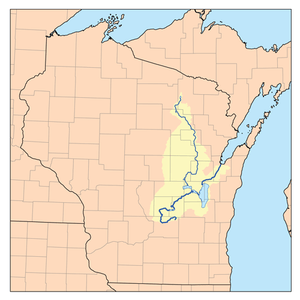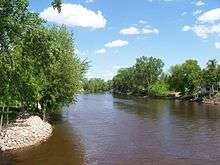Wolf River (Fox River)



The Wolf River, 225 miles (362 km) long,[1] is one of the two National Scenic Rivers in Wisconsin, along with the St. Croix River. The scenic portion is 24 miles (39 km) long.[2] It rises in the north woods of the state, with the northernmost fork stemming from Pine Lake in Forest County. The river flows south through Langlade and Menominee counties, where whitewater rafting is well known. Menominee County is mostly within the boundaries of the federally recognized Menominee Indian Reservation.
Next the Wolf River flows through Shawano County, where it collects the Red River, passes by the city of Shawano, then flows through Waupaca and Outagamie counties and back into Waupaca County, where it collects the Embarrass River at the city of New London. The final stretch of the Wolf River collects the Little Wolf and the Waupaca rivers just below New London, then passes through Winnebago County, through Lake Poygan and the city of Winneconne to empty into Lake Butte des Morts on the Fox River.
Environmental concerns
Environmentalists were concerned about preserving the river when the Crandon mine was proposed near a tributary of the river.[3] The Crandon Mine was purchased by the Sokaogon Mole Lake Chippewa Band tribe in 2003 to prevent development that would adversely affect the river.[4] The campaign to stop the Crandon Mine on the Wisconsin's Wolf River was the result of successful coalition-building efforts amongst Wisconsin's indigenous groups, environmentalists, and rural citizens.[5]
Sturgeon guard
This river is noted for the sturgeon which spawn annually in the springtime in the Wolf River and its parent, the Fox River, between approximately April 15 and May 5, as they swim upstream from Lake Winnebago. It is estimated that the extent of the lake sturgeon has dropped to about one-tenth of its population in the state since year 1800. This species, which has existed since the time of the dinosaurs (100 million years ago), has a viable naturally reproducing population, which are highly prized for the taste of their flesh, and also for their eggs. These are said to rival those of the beluga sturgeon of Russia and Ukraine, in quality and price. Female sturgeon deposit their eggs only about every four to six years, starting at 20 years old, up to their life span of 50 years. At this age, the sturgeon are five feet long. The fish spawn in the shallows of the Wolf river, as they swim upstream.
In order to protect the spawning locations of the sturgeon from poaching when the fish are the most vulnerable, the Wisconsin Department of Natural Resources formed a citizen sturgeon guard called Sturgeon For Tomorrow in the early 1990s. They volunteer to watch over the spawning sites during the spawning season. The head guard, or "sturgeon general" assigns the site, an identifying hat (and souvenir), and cell phone for the 12-hour shift. The guards are warned not to confront poachers, but to call in the incident to the armed wardens. The program is very popular in the state and weekend volunteer slots are filled quickly.
Walleye
The walleye is very popular during their spawning period, during the spring. Many fishermen set out to catch their daily limit. The walleye is probably the most prized fish on the river.
White Bass
The white bass or sand bass (Morone chrysops) is a freshwater fish of the temperate bass family Moronidae that also spawns in the Wolf River. The spring spawn typically occurs during the last two weeks of May when the female of the species is prevalent. During this time, a huge influx of fisherman (boating and shore) are attracted to the entire Wolf system. The average white bass taken from the Wolf watershed typically measures 200–300 mm (8-12 inches) in length with a maximum of about 475 mm (19 inches). While different fishing methods and techniques are used , the most common is the river rig (also known as the Wolf River rig).
See also
References
| Wikimedia Commons has media related to Wolf River (Fox River). |
- ↑ U.S. Geological Survey. National Hydrography Dataset high-resolution flowline data. The National Map, accessed December 19, 2011
- ↑ Wolf River at the National Park Service
- ↑ Website opposing the Crandon Mine near the Wolf River
- ↑ "New tribal purchase provides further protection against Crandon Mine, Nov. 14, 2006"
- ↑ Menominee Treaty Rights and Mining Impacts (2000).The book, To Slay a Giant, by John J. Mutter, Jr., was written about the two year struggle to get a mining moratorium passed in the Wisconsin Legislature. "Chronology of Crandon Mine" http://www.alphacdc.com/treaty/crn_chronology.html
Coordinates: 44°05′33″N 88°41′33″W / 44.09250°N 88.69250°W